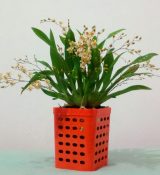Learn to Speak Your Orchid’s Language
Author: Melanie Dearringer4 Comments
Care and Culture, Growing Indoors

Have you ever wondered what your orchid would say if it could talk? Would it tell you that it’s thirsty and could use some more water? Or perhaps it would say that it isn’t feeling well and may have contracted some sort of illness. Interestingly enough, orchids are actually quite good at communicating their needs to their caretakers. You just have to learn to speak their language. Below you will learn to decode the appearance of your orchid leaves and start down the path to a happier and healthier orchid.
LIMP LEAVES
Limp leaves are usually a sign of a watering problem. Both over-watering and under-watering can cause your orchid’s leaves to become wrinkly and leathery in appearance. So how do you determine the problem? Take a look at the roots. Healthy orchid roots will be green in color. If your orchid’s roots are gray, it would be safe to assume the plant is being under-watered. Alternatively, if the roots are brown and mushy, the plant has experienced root rot caused by over-watering. Without the presence of healthy roots, your orchid can no longer take up the water it requires causing the plant to dehydrate. In this case you will want to remove the diseased roots, repot the orchid, and raise the humidity near the orchid by misting the leaves several times a day.
YELLOW LEAVES
Yellow spots on your orchid’s leaves are a good indicator that it is receiving too much direct light. While orchids need bright light to thrive, exposing them to direct light will cause the leaves to burn. This usually starts with yellow spots visible on the leaves and will turn to a white or bleached color before they die off. If you suspect your orchid is suffering from a sunburn, move the plant to a location that receives indirect light such a window with a sheer curtain that will help block the harshness of the sun.
If the bottom leaf of your orchid is yellowing, don’t be alarmed. Your orchid will naturally shed its bottom leaf as it produces a new leaf from the top.
BROWN LEAVES
Brown leaves are a sign of illness. Most likely some sort of disease, bacterial or fungal, has infected your orchid. Be sure to quarantine your plant until you are able to identify and treat the illness.
BLACK LEAVES
Black leaves are a sign of a fungal disease called black rot. Black rot shows itself as dark spots that grow rapidly and spread quickly. You will want to stop the spread of this disease by removing the infected portions of the leaves with a sharp, sterilized blade. Be sure to remove a small amount of the healthy tissue that borders the disease to ensure you’ve removed all the fungus. Treat the cut tissue with a fungicide (cinnamon is a great natural fungicide that can be used for this purpose) and move the plant to an area with good air circulation. If the black rot is not controlled quickly enough and reaches your orchid’s crown, it will kill your plant.
4 Responses to “Learn to Speak Your Orchid’s Language”
Leave a Reply


Ask an Expert
Questions about orchids?
Our experts love a challenge!
Photo of the Week
Submit your photo to be featured on the blog!
More Photo of the Week Winners
Submit Photo










Interesting!
Thanks for sharing, melanie!
Good to know about leaves.
I always thought my orchids were dead :-/